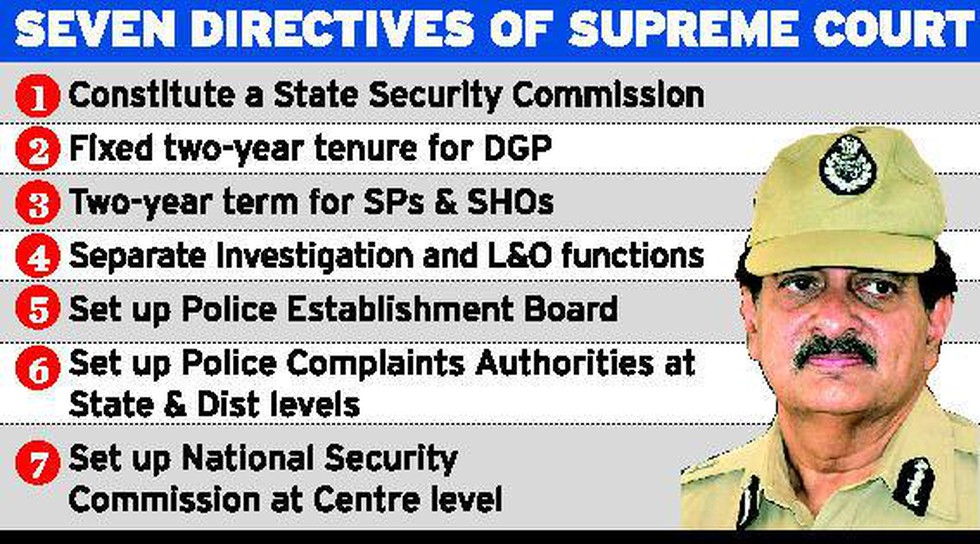Police Reforms
Why in News
In a recent reply in the Parlaiment, the government disclosed that between 1st April and 30th November, 2015, 25,357 cases were registered under police category which included 111 deaths in police custody, 330 cases of custodial torture and 24,916 in others.
- This data again lays emphasis on the need to make police accountable and carry out police reforms.
Key Points
- Police Reforms (Meaning):
- Police reforms aim to transform the values, culture, policies and practices of police organizations.
- It envisages police to perform their duties with respect for democratic values, human rights and the rule of law.
- It also aims to improve how the police interact with other parts of the security sector, such as the courts and departments of corrections, or executive, parliamentary or independent authorities with management or oversight responsibilities.
- Police come under the state list of schedule 7 of the Indian constitution.
- Committees/Commissions on Police Reforms:
- Issues Concerning Police Forces:
- Colonial Legacy: The Police Act of 1861 was legislated by the British right after the revolt of 1857 to bring in efficient administration of police in the country and to prevent any future revolts.
- This meant that the police were to always comply with those in power.
- Accountability to the Political Executives vs Operational Freedom: The Second Administrative Reforms Commission (ARC-2007) has noted that political control has been abused in the past by the political executive to unduly influence police personnel, and have them serve personal or political interests.
- Psychological Pressure: While improvements in pay scale and promotions are necessary aspects of police reforms, little has been spoken about reforms needed at the psychological level.
- In the Indian police force, the lower ranks of police personnel are often verbally abused by their superiors or they work in inhuman conditions.
- This non-harmonious work environment ultimately affects their relationship with the public.
- Public Perception: The Second ARC has noted that police-public relations is in an unsatisfactory State because people view the police as corrupt, inefficient, politically partisan and unresponsive.
- Further, citizens in general fear going to a police station or dealing with the lower ranks of the police forces.
- Overburdened Force: While the sanctioned police strength was 181 police per lakh persons in 2016, the actual strength was 137 police.
- This is way too low when compared with the United Nations’ recommended standard of 222 police per lakh persons.
- Further, a high percentage of vacancies within the police forces exacerbates an existing problem of overburdened police personnel.
- Constabulary Related Issues: The constabulary constitutes 86% of the State police forces and has wide-ranging responsibilities.
- Infrastructural Issues: Modern policing requires strong communication support, state-of the-art or modern weapons, and a high degree of mobility.
- However, CAG audit reports of year 2015-16, have found shortages in weaponry with state police forces.
- For example, Rajasthan and West Bengal had shortages of 75% and 71% respectively in required weaponry with the state police.
- Also, the Bureau of Police Research and Development has also noted a 30.5% deficiency in stock of required vehicles with the state forces.
- Colonial Legacy: The Police Act of 1861 was legislated by the British right after the revolt of 1857 to bring in efficient administration of police in the country and to prevent any future revolts.
Suggestions
- Modernisation of Police Forces: The Modernisation of Police Forces (MPF) scheme was initiated in 1969-70 and has undergone several revisions over the years.
- However, there is a need to fully utilize the finances sanctioned by the government.
- MPF scheme envisages:
- Procurement of modern weapons
- Mobility of police forces
- Logistics support, upgradation of police wireless, etc
- A National satellite network
- Need For Political Will: The Supreme Court in the landmark Prakash Singh case (2006) gave seven directives where considerable work in police reforms is still needed.
- However, due to the lack of political will these directives were not implemented in letter and spirit in many states.
- Revamping Criminal Justice System: Along with Police reforms, there is a need to reform the criminal justice system too. In this context, the recommendations of the Menon and Malimath Committees can be implemented. Some of the key recommendations are as follows:
- Creation of a fund to compensate victims who turn hostile from the pressure of culprits.
- Setting up separate authority at the national level to deal with crimes threatening the country's security.
- A complete revamp of the entire criminal procedure system.

